Hasegawa 1/48 Airacobra I/P-400
The Airacobra I was an export version of the P-39 very similar to the P-39D, other than the 37mm Oldmobile cannon was exchanged for a 20mm Oerlikon. The Airacobra I went operational with 610 Squadron in the fall of 1941, where it was quickly discovered that the Airacobra did not meet the requirments of air combat over western Europe.
The USAAF took over all undelivered Airacobra Is after Pearl Harbor, designating them as P-400s. Most ended up in the South Pacific or New Guinea. The Airacobra Is that had been delivered to Britain were sent to the USSR with the first delivery in December 1941 and further deliveries through to June 1942, for a total of 212 aircraft. These supplemented US deliveries of the P-39D-2 under Lend-Lease. The arrival of these 212 aircraft beginning in the spring of 1942 was very timely.
The crated Airacobras were unloaded in Murmansk and went directly to the active aviation units of the VVS Northern Fleet of the 78th IAP, or were transported by rail to the Karelian Front where they were issued to the 19th Guards IAP. The Airacobras served primarily on the Arkangel and Leningrad Fronts.
Test flying revealed the Airacobra had excellent speed and maneuverability at the altitudes at which most combat over the Eastern Front occurred and that the airplane could be flown by pilots of average ability with less than 20 hours of training in type. The tendency to enter a flat spin was the one bad flight area. It would not be until the aircraft entered operational service that the tendency of the Allison engine to throw connecting rods would be discovered. It was decided that the Airacobra would only be issued to units with combat experience so that the pilots could make the best use of it quickly.
The Airacobra first entered combat with the 2d Guards Mixed Air Regiment of the AV/MF, the Soviet Naval Air Force, at Murmansk in late February 1942. The unit flew I-16s, Hurricanes and Tomahawk II fighters in defense of the convoys coming to Murmansk and the port.
The first VVS unit to transition to the Airacobra I was the 145th IAP, which they did in March 1941 at their operational airfields without any instruction manuals. The unit entered combat over Arkangel in early April 1941 and was soon successful as bomber interceptors. Effectiveness grew as the pilots became more familiar with the aircraft. For example, on 15 June six 6 Airacobras intercepted six bombers and 16 escorting Bf 110 fighters in the area of Murmashy airfield, headed toward Murmansk. In the engagement that followed, nine German aircraft were shot down without loss.
Two fighter regiments, the 153rd and 185th IAPs, were formed on the Airacobra I in the course of 1942. The 153d IAP arrived for re training from the Leningrad Front on 25 March 1942. The re training of the unit took 27 days, with an average of 12 flight hours per pilot. By 10 June 1942 the regiment had completed transition and on 14 June was sent to Voronezh Front, composed of two squadrons with 20 aircraft and 23 pilots each, under the command of Hero of the Soviet Union Major S. I. Mironov, arriving on 29 June 1942. In July the regiment relocated to Lipetsk airfield, from which it operated until 25 September 1942. In 59 flying days on the Voronezh Front the regiment conducted 1,070 combat sorties with 1162 hours of flight time; fought 259 aerial engagements, of which 45 were of a group nature; shot down 64 enemy aircraft, of which 18 were bombers (15 Ju 88, 1 Do 217, 1 He 111, and 1 FW 198), 45 fighters (39 Bf 109F, 1 Bf 110, 1 Me 210, 4 MS 200), and 1 aerial observation aircraft. Losses during these three months of combat were 3 pilots and 8 aircraft. On 22 November 1942 the 153rd IAP received the Guards title and was renamed the 28th Guards IAP. In November 1943 the regiment received the honorific title "Leningradskiy" (28th Guards "Leningradskiy" IAP). They exclusively flew the Airacobra I until August 1943 when they began to receive P-39N and P-39Q aircraft through Lend-Lease.
The 19th Guards IAP transitioned to the Airacobra in August 1942 and was involved in heavy combat throughout the rest of the year on the Leningrad front. The unit began to receive P-39Ns in February 1943 through Lend-Lease, but the last Airacobra I was used until March 1944.
In December 1942, the commander of the 28th Guards IAP reported on the unit's combat experience in the Voronezh and West Fronts in July August 1942: "The Airacobra aircraft is considered by the Germans to be the most dangerous enemy and should be engaged in combat only when they [the Germans] have numerical superiority and the advantage in altitude and surprise."
The Airacobra I may not have worked over France and might have been a distant second choice for pilots at Guadalcanal or Port Moresby, but over Murmansk and Leningrad, it established the good reputation the P-39 would have with the Red Air Force for the rest of the war.
I picked this kit up at an estate sale held at the local hobby shop for $17.95, a price that is about 1/4 of the contemporary Hasegawa price for their P-39s, which I think are overall the best P-39 kits available.
I pre painted the detail parts, these being the cockpit, gear wells, landing gear and gear doors, which are all done in “Bell Green.” Having seen the very accurate P 39 restoration at Yanks Air Museum in Chino, I can assure you that this color is US Medium Green nothing special or out of the ordinary, other than it being a different color from interior green which was used by most other manufacturers. You can use any available Medium Green you want for this. In my case, I used Xtracrylix Medium Green.
The Airacobra Is were delivered to the RAF in Dupont Dark Earth (a different shade than RAF Dark Earth) and Medium Green upper surfaces and a Light Grey lower surface. The British then painted the Airacobras with RAF Ocean Grey before they went operational, and the airplanes were all delivered in this scheme to the USSR. I used Tamiya Ocean Grey and Medium Green for the upper colors and Sky Grey for the lower, all over an overall flat black primer. I "overpainted" the British national insignia with RAF Dark Green.
I used decals from several old sheets in the Decal Dungeon to come up with the red stars, tail number and Guards insignia to do an Airacobra of the 28th Guards IAP.
Since these airplanes saw hard service, I dinged the model and applied heavy exhaust stains. I cut off the lower main gear doors, as I found several photos of the airplanes with the doors removed for operation from muddy Russian airfields.

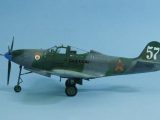

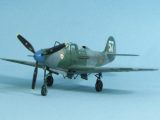

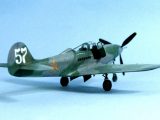
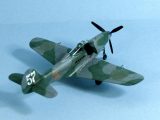
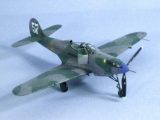
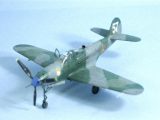



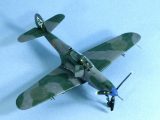
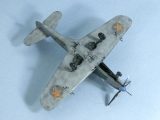
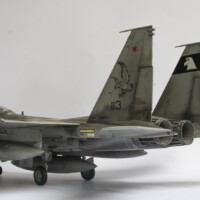

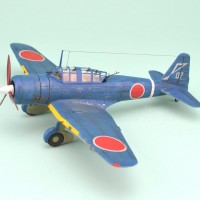
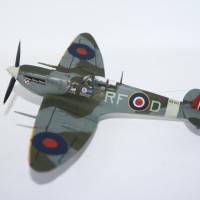
Nice Snake. The Russians also liked the US radios and found them to be more reliable then their own.
Nice. A piece of history not well known.
beautiful
Looks nice as usual.
Great job as usual, Tom. Like the history lesson that you provide, as it adds another element, albeit a little known element.
I agree with your assessment that Hasegawa's P-39 is the better of the 1:48 scale kit, but don't count out Monogram!
I've always thought that Monogram's kits are, for the money, the best "bargain" around...they're accurate, fit well and make for an enjoyable build. Wish they were still in the business (dunno why, but Revell just ain't the same, IMO).